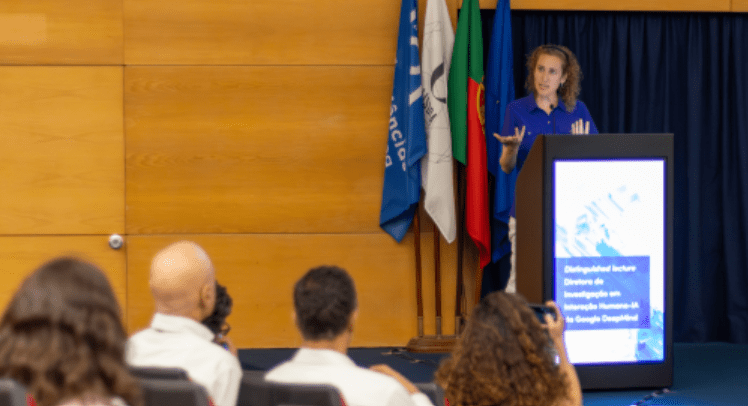Meredith R. Morris, Director of Human-AI Interaction at Google DeepMind and member of the LASIGE Advisory Board, was invited to give a talk by the LASIGE Executive Committee (Alysson Bessani, Tiago Guerreiro and Cátia Pesquita). The Distinguished Lecture entitled “Human-Computer Interaction (HCI) for Artificial Generalist Intelligence (AGI)” took place on 15 July 2025 and was hosted by Ciências ULisboa.
With a full audience in the Great Auditorium, after a brief introduction and enthusiastic for the new technological paradigm, Meredith admitted that “it is possible that the first AGI systems will appear on the market within two to five years, with the appearance of the first systems based on algorithms, which cover different areas of knowledge and perform tasks in various contexts, just like humans. It is even expected that AGI will be able to move up the knowledge ladder and even integrate the knowledge aggregated over time by human experts from various fields of knowledge within 10 years”.
Morris also mentioned some factors that could slow down the growing use of AI, as application of regulation by governments, energy or environmental capacity limitations, or the need of new paradigms but added “There is now an opportunity to develop new formats (of interaction) that take our principles into account and we need to analyze people’s reactions before releasing these things freely onto the market”.
Also emphasized that “Instead of thinking that AI is going to automate everything, we should see it as something that has the capacity to unlock (functions). Maybe sometimes we’ll want it to do everything autonomously, and other times we’ll prefer it to collaborate with us as an assistant” and “We can’t exchange people for chatbots right now if they’re not reliable and we can’t explain what they’re doing”.
As a final note, Meredith R. Morris expressed that it is very important and powerful to audit and explain AI, especially in state functions.

